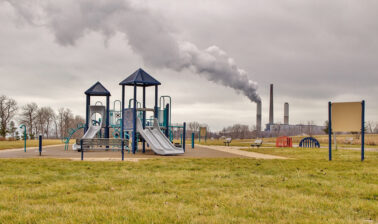Infographics
Air Pollution and Environmental Justice
Published on: July 22, 2020. Updated on: March 04, 2022.
About the Data Insights
Outdoor air pollution kills around 4.2 million people worldwide each year. Researchers in the US have suggested air pollution has significantly worsened the COVID-19 pandemic and potentially led to more deaths than if pollution-free skies were the norm. This infographic will explore how different neighborhoods in the same city can have vastly different air quality and what that means for their residents’ short- and long-term health outcomes.
Air Pollution Related Deaths: Global Alliance on Health and Pollution, Pollution and Health Metrics: Global, Regional and Country Analysis, December 2019
- NOTE: These numbers are rough estimates, with a large degree of uncertainty. Many different groups estimate this number to be higher or lower, anywhere from 30,000 - 250,000 total premature deaths due to air pollution per year.
Two Air Pollutants in US: American Lung Association, State of the Air: Health Effects of Ozone and Particle Pollution, April 2020
- NOTE: These are just two pollutants out of the main six. The EPA has identified six pollutants as “criteria” air pollutants because it regulates them by developing human health-based and/or environmentally-based criteria for setting permissible levels.
- Carbon Monoxide
- Lead
- Nitrogen Oxides
- Ground-level Ozone
- Particulate Matter
- Sulfur Oxides
Ozone and PM2.5 Definitions: National Association of Clean Air Agencies, Air Pollutants
- NOTE: Ozone is a gas composed of three atoms of oxygen (O3). Ozone occurs both in the Earth's upper atmosphere and at ground level. Ozone can be good or bad, depending on where it is found. Ozone at ground level is a harmful air pollutant, because of its effects on people and the environment, and it is the main ingredient in “smog."
- NOTE: PM2.5 stands for particulate matter (also called particle pollution) that is a made up of fine inhalable particles, with diameters that are generally 2.5 micrometers and smaller. Some particles, like soot, are large or dark enough to be visible to the naked eye, while others are so tiny they can only be seen with an electron microscope. PM2.5 which can enter deep into the lungs and even into the bloodstream.
Contributions to Air Pollution: Science X Network, What Causes Air Pollution?, April 2016
Agriculture Contributing to Air Pollution: "Significant atmospheric aerosol pollution caused by world food cultivation," Advancing Earth and Space Science, May 2016
- NOTE: Agricultural air pollution comes mainly in the form of ammonia, which enters the air as a gas from heavily fertilized fields and livestock waste. It then combines with pollutants from combustion—mainly nitrogen oxides and sulfates from vehicles, power plants and industrial processes—to create tiny solid particles, or aerosols, no more than 2.5 micrometers.
Health Risk from Air Pollution: American Lung Association, State of the Air: Health Effects of Ozone and Particle Pollution
Relationship Between Air Pollution and COVID-19: Environmental Defense Fund, The truth about coronavirus, air pollution and our health
Air Pollution Increases COVID-19 Deaths: “Exposure to air pollution and COVID-19 mortality in the United States: A nationwide cross-sectional study,” Harvard T.H. Chan School of Public Health, April 2020
- NOTE: The "long-term exposure" in this study refers to the annual (1-year) mean, the same as the definition of NAAQS table (https://www.epa.gov/criteria-air-pollutants/naaqs-table). The main exposure is calculated by averaging the annual mean over 17 years (2000-2016), making it “historical long-term exposure.”
Where Americans Spend Their Day: Environmental Protection Agency, Why Indoor Air Quality: What are the trends in indoor air quality and their effects on human health?, July 2018
Living Near Highways: American Lung Association, Living Near Highways and Air Pollution, April 2020
Living Near Factory Farms:"Understanding Concentrated Animal Feeding Operations and Their Impact on Communities," National Association of Local Boards of Health, 2010
- NOTE: A factory farm is a concentrated animal feeding operations (CAFO) or large industrial agricultural facility that raises animals, usually at high-density, for the consumption of meat, eggs, or milk.
PM2.5 Heat Map: America’s Health Rankings: United Health Foundation, Annual Report: National Air Pollution, April 2010-July 2018
People Living with Poor Air Quality: American Lung Association, State of the Air: People at Risk, 2020
- NOTE: 45.8 percent of people in the United States live in counties with unhealthful levels of either ozone or particle pollution. Approximately 150 million Americans live in these 257 counties with unhealthful levels of either ozone or short-term or year-round particles.
Pollution Inequality: “Inequity in consumption of goods and services adds to racial–ethnic disparities in air pollution exposure,” Proceedings of the National Academy of Sciences of the United States of America, March 2019
- NOTE: This study measures emissions output by consumption using Extended InMAP Economic Input–Output (EIEIO). EIEIO uses economic data to trace human end-use activities that directly and indirectly cause air pollutant emissions and the resulting human exposure to PM2.5. The model tracks relationships between final “end users,” the activities or “end uses” they are participating in that induce air pollution emissions, and the “emitter” entities that are physically releasing air pollutant emissions. EIEIO tracks 19 end-user types, 389 end-use categories, and 5,434 categories of emitters. This study presents results in groups of four users, seven uses, and fourteen emitters.
Prevent, Control, Reduce: Solar Impulse Foundation, Solutions to Air Pollution: How to Improve Air Quality?
Organic Agriculture: Environmental Protection Agency, Nutrient Pollution: The Sources and Solutions: Agriculture, April 2019
More Related Content
See More on: Coronavirus | Environmental Health | Social Determinants of Health

